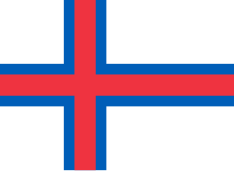
Back علم جزر فارو Arabic Сцяг Фарэрскіх астравоў Byelorussian Сьцяг Фарэрскіх астравоў BE-X-OLD Национално знаме на Фарьорските острови Bulgarian Zastava Farskih ostrva BS Bandera de les illes Fèroe Catalan Faerská vlajka Czech Baner Ynysoedd Ffaröe Welsh Færøernes flag Danish Flagge der Färöer German
 | |
| Merkið | |
| Use | National flag and civil ensign |
|---|---|
| Proportion | 8:11 |
| Adopted | 25 April 1940 |
| Design | A blue-fimbriated red Nordic cross on a white field |
| Designed by | Jens Oliver Lisberg |
Preview warning: Page using Template:Infobox flag with unknown parameter "Type"


The flag of the Faroe Islands (in Faroese: Merkið) is an offset cross, representing Christianity. It is similar in design to other Nordic flags – a tradition set by the Dannebrog of Denmark,[1][2] of which the Faroe Islands are an autonomous territory.[3]
The flag is called Merkið, which means "the banner" or "the mark". It resembles the flags of neighbouring Norway and Iceland.
- ^ Andrew Evans (2008). Iceland. Bradt. ISBN 9781841622156. Retrieved 2007-12-31.
Legend states that a red cloth with the white cross simply fell from the sky in the middle of the 13th-century Battle of Valdemar, after which the Danes were victorious. As a badge of divine right, Denmark flew its cross in the other Scandinavian countries it ruled and as each nation gained independence, they incorporated the Christian symbol.
- ^ The Australian Flag: Colonial Relic or Contemporary Icon. William Gaunt & Sons. 2010. ISBN 978-9004181489. Retrieved 2007-12-31.
The Christian cross, for instance, is one of the oldest and most widely used symbols in the world, and many European countries, such as the United Kingdom, Norway, Sweden, Finland, Denmark, Iceland, Greece and Switzerland, adopted and currently retain the Christian cross on their national flags.
- ^ * Benedikter, Thomas (2006-06-19). "The working autonomies in Europe". Society for Threatened Peoples. Archived from the original on 2008-03-09. Retrieved 2019-08-30.
Denmark has established very specific territorial autonomies with its two island territories
- Ackrén, Maria (November 2017). "Greenland". Autonomy Arrangements in the World. Archived from the original on 2019-08-30. Retrieved 2019-08-30.
Faroese and Greenlandic are seen as official regional languages in the self-governing territories belonging to Denmark.
- "Facts about the Faroe Islands". Nordic cooperation. Archived from the original on 23 April 2018. Retrieved 1 July 2015.
The Faroe Islands […] is one of three autonomous territories in the Nordic Region
- Ackrén, Maria (November 2017). "Greenland". Autonomy Arrangements in the World. Archived from the original on 2019-08-30. Retrieved 2019-08-30.
© MMXXIII Rich X Search. We shall prevail. All rights reserved. Rich X Search